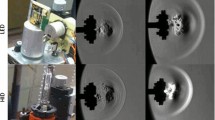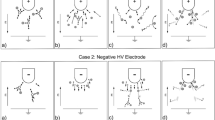Abstract
Single-shot color schlieren photography of supersonic flow phenomena requires a technically complex flash light source. In particular, it should be of ultrashort duration to minimize motion blur, of high intensity to expose regular color film with only one flash, and should emit an almost “white” spectrum to provide the full scale of possible hues. Furthermore, matching Settles' (1970) direction indicating color dissection method the source should be of an areal geometry to uniformly illuminate a tricolor filter in the source plane. Two different types of light sources have been constructed and compared to each other: an array of five Xe-filled linear flash lamps and a module of eight closely stacked U-shaped loops of micro gliding sparks. The spark module consists of a total of 280 individual micro gliding discharges which are all arranged uniformly within an area of 40×40 mm. Connected in a series and pulsed by a modified eight-stage 15 kV Marx-surge generator they are operated in a nitrogen gas atmosphere doped with xenon by about 15% of volume at a total pressure of 1.5 bar. The emitted flash has a peak light intensity of 29 Mcd and a flash duration of 292 ns FWHM. Advantageously in comparison to flash lamps, the flash of a gliding spark module is shorter and free of oscillatory afterglow, thus providing clear and sharp schlieren photos of shock waves which, for example, are purged from preceding “phantom shock fronts”.
Similar content being viewed by others
References
Beams JW, Kuhlthau AR, Lapsley AC, McQueen JH, Snoddy LB, Whitehead Jr. WD (1947) Spark light source of short duration. J Opt Soc Am 37: 868–869
Barnes NF, Bellinger SL (1945) Schlieren and shadowgraph equipment for air flow analysis. J Opt Soc Am 35: 497–509
Ciezki H (1984) Entwicklung eines Farbschlierenverfahrens unter besonderer Berücksichtigung des Einsatzes an einem Stoßwellenrohr. Diploma Thesis, Lehrstuhl für Allgemeine Mechanik, RWTH Aachen, Germany
Davies TP (1982) Schlieren photography — review, applications, and bibliography. Proc. 15th Int. Congr. High-Speed Photography and Photonics, San Diego, USA. SPIE 348: 878–885
Edgerton HE, Tredwell J, Cooper Jr KW (1960) Submicrosecond flash sources. In: Courtney-Pratt JS, Cantab BE (eds): Proc. 5th Int. Congr. High Speed Photography. SMPTE, New York, pp 29–32
Edgerton HE (1979) Electronic Flash, Strobe. MIT Press, Cambridge, MA and London, pp 131–133
Früngel FBA (1965) High Speed Pulse Technology, Volume II: Optical Pulses, Lasers, Measuring Techniques. Academic Press, New York and London, pp 11–15
Früngel FBA (1980) High Speed Pulse Technology, Volume IV: Sparks and Laser Pulses. Academic Press, New York London Toronto Sydney and San Francisco pp 299–303
Holder DW, North RJ (1963) Schlieren Methods. In: Notes on Applied Science No.31, National Physical Laboratory. Her Majesty's Stationery Office, London, pp 38–61
Hyzer WG (1962) Engineering and Scientific High-Speed Photography. Macmillan, New York p 434
Kleine H, Gvozdeva LG, Grönig H (1990) Visualization of transition phenomena by means of a 2-D color schlieren method. Proc. 9th Int. Mach Reflection Symposium, June 18–21, 1993, EMI, Freiburg
Kleine H, Grönig H (1991) Color schlieren methods in shock wave research. Shock Waves 1: 51–63
Kleine H, Grönig H (1993) Visualization of transient flow phenomena by means of colour schlieren and shearing interferometry. Proc. 20th Int. Congr. High-Speed Photography and Photonics, Victoria, Canada. SPIE 1801: 400–409
Krehl P, Engemann S (1993) A high-intensity diffuse light source of ultrashort duration for reflected-light color photography. Rev Sci Instrum 64: 1785–1793
Krehl P (1993a) Funkenlichtquelle mit ultrakurzer Lichtdauer. German Patent P 4223457
Krehl P (1993b) Die Entwicklung von Kurzzeitlichtquellen am Ernst-Mach-Institut. Rep. 10/93 EMI Freiburg, Germany
Miyashiro S, Grönig H (1985) Low-jitter reliable nanosecond spark source for optical short-duration measurements. Exp Fluids 3: 71–75
Miyashiro S, Kleine H, Grönig H (1993) Short duration source for colour schlieren methods. Proc. 20th Int. Congr. High-Speed Photography and Photonics, Victoria, Canada. SPIE 1801: 248–257
North RJ (1960) The argon-jet spark light source. National Physical Laboratory Report NPL/Aero/419, Teddington, United Kingdom
North RJ (1973) Schlieren photography and allied techniques. In Woodlief T, Jr (ed): SPSE Handbook of Photographic Science and Engineering. Wiley, New York London Sydney Toronto, pp 1162–1180
Pope A, Goin KL (1965) High-speed wind tunnel testing. Wiley, New York London Sidney, pp. 232
Ruiyi C, Zhoufang G (1988) Color schlieren system using square color filter and its application to aerofoil test in transonics. Proc. 18th Int. Congr. High-Speed Photography and Photonics, Xian, China. SPIE 1032: 845–849
Seitz MW, Scott DM, Skews BW (1992) A two-dimensional colour schlieren system with adjustable sensitivity. Proc. 20th Int. Congr. High-Speed-Photography and Photonics, Victoria, Canada. SPIE 1801: 410–416
Settles GS (1970) A direction indicating colour schlieren system. AIAA Journal 8: 2282–2284
Settles GS (1982) Color schlieren optics — A review of techniques and applications. In: Merzkirch W (ed) Flow visualization II. Hemisphere Publishing Corp., New York, pp 749–759
Skews BW (1994) Private communication. School of Mechanical Engineering, University of Witwatersrand, Johannesburg, South Africa
Stong CL (ed), Settles GS (1971) Schlieren photography is used to study the flow around small objects. Scientific American 224(5): 118–124
Stong CL (ed), Vandiver JK (1974) An air flash lamp advances color schlieren photography. Scientific American 231(8): 104–109
Vandiver JK, Edgerton HE (1974) Color schlieren photography of short duration transient events. Proc. 11th Int. Congr. High-Speed Photography and Photonics, London, Great Britain. In: High Speed Photography. Chapman and Hall, London, pp 398–403
Vasil'ev LA (1971) Schlieren methods. Israel Program For Scientific Translations, New York Jerusalem London, pp 65–68, 146–148
Vogel A (1994) Private communication. DLR, 74239 Lampoldshausen, Germany
Author information
Authors and Affiliations
Rights and permissions
About this article
Cite this article
Krehl, P., Engemann, S. & Neuwald, P. Flash lighting instrumentation for color schlieren shock wave photography. Shock Waves 4, 195–207 (1995). https://doi.org/10.1007/BF01414985
Received:
Accepted:
Issue Date:
DOI: https://doi.org/10.1007/BF01414985




